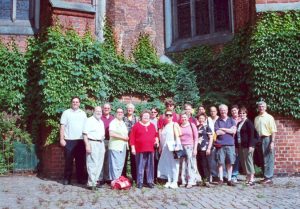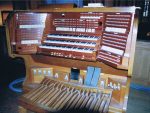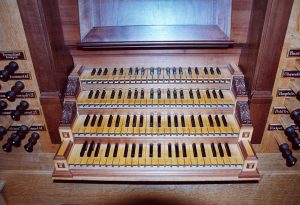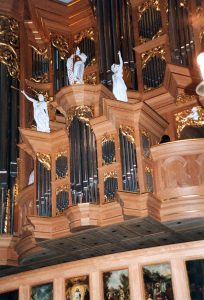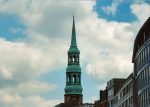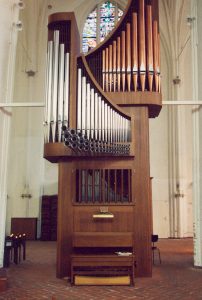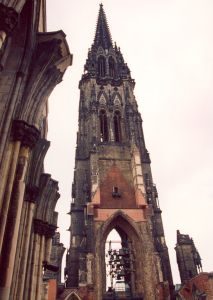Historic Organs of Germany
June 11, 2003
Hamburg
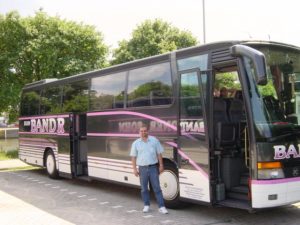 After an eventful flight, which included avoiding an Air France strike in Paris by only an hour and leaving only three bags behind, we made it to our Hamburg hotel some time in the late afternoon June 10. Several in the group had started the trip well over twenty-four hours before, changing planes for a total of five different flights. It wasn’t surprising that some of us used the time to check out the neighborhood, while others took to their rooms in exhaustion.
After an eventful flight, which included avoiding an Air France strike in Paris by only an hour and leaving only three bags behind, we made it to our Hamburg hotel some time in the late afternoon June 10. Several in the group had started the trip well over twenty-four hours before, changing planes for a total of five different flights. It wasn’t surprising that some of us used the time to check out the neighborhood, while others took to their rooms in exhaustion.
Over the next two days we had the opportunity to tour the city by bus, to take a canal tour by boat, to cruise the Alster, to walk through the beautiful parks, to have our first taste of the local Aalsupppe, and to discover this wonderful city. We also got to know Dirk Lamy, our bus driver and guide for the entire trip. His friendly nature and willing spirit were to be touchstones of the entire week, and we would all rely on him for much more than his contract required. In fact, if you ever have the opportunity to ride a tour bus through Germany, we’d all heartily recommend Dirk as your driver!
Soon after breakfast June 11, we gathered in the lobby for a short discussion of the instruments we would see over the next two days. Some of our group were experienced players with backgrounds that let them know what to expect in each place, but others were somewhat intimidated by the information they had received earlier. You can see a copy of the pre-trip information here. Because of the itinerary—and geography, of course—we were to begin our trip with older instruments, so we talked first about the characteristics of seventeenth-century North German instruments. Knowing we were about to visit one of the most well-known organs built by Arp Schnitger made us all the more excited as we talked about our expectations. Finally, after a short bus ride to orient ourselves a little and to establish a meeting place for the afternoon, we set out on foot for the Jacobikirche.
Jacobikirche
The first thing we did was gather in the courtyard of the church for a group picture. Here we are, filled with excitement, but not really sure what would happen next. As it turned out, when we rounded the corner, leaving the sunlight and searching for an open door, our host Rudolf Kelber, organist of St. Jacobi, rode up on a bicycle and ushered us directly into the loft.
It was a little disconcerting to walk past this console as we went through the loft. Surely this instrument had not been “electrocuted” since we last heard about it? Wasn’t this supposed to be a model of restoration and preservation? Given the remarkable history of this instrument, its trials and troubles, had an additional electric action been added? On the other hand, the console (which actually belongs to another, much newer instrument in the church) gave some of us our first look at a console that had a Walze and had those fascinating rows of switches below each stop tab. Learning about that kind of organ would wait for Berlin, however, and we quickly moved past, toward our real goal.
Our visit started in a rehearsal room immediately behind the great Schnitger organ. In a most engaging manner, Herr Kelber told us much about the church, its history, the music program and current activities, and—most importantly—the organ itself. During his talk, he played excerpts from his Missa super Cantica lennonenses mcartnesque for us, giving us all a chance to see a side of his personality that is not directly related to the famous instrument that brought us there. We received an autographed copy before we left, and it will be interesting to see which one of us performs it in church first. His overview of the history of the instrument concentrated on the early stages of its existence, and he carefully pointed out the lineage of its various components up through Schnitger’s work. Michael Jackson made this photograph.
When Herr Kelber finished preparing us, we were ready to move into the gallery and get our first look at the organ. We knew that the Jurgen Ahrend’s work completed in 1993 had restored the short octaves on three manuals and pedal, and that the organ now has split keys on the Rückpositiv to accomodate the F# and G# within the same space, but it was a little disconcerting to look down and wonder just what to expect when you played a note in that range.
The demonstration that followed, however, made us forget about any minor matters as Herr Kelber played the sounds that put all of his earlier comments into a musical context. Beginning with the oldest ranks retained by Schnitger, he played the principals on each division, the choruses, the flutes, and many of the reeds. He even played the eighteenth-century Viol da Gamba, coupled to the 8′ Principal of the Brustwerk, and improvised in a very convincing Italian manner, à la Frescobaldi.
Even though I have heard Schnitger organs before, I was once again blown away by the sound of the chorus—any one of them, in this case. Comparisons are difficult to make, of course, and depend entirely on the experiences of the listener or reader to be effective. Nevertheless, I’m compelled to try to put some thoughts down about the sound of an authentic North German chorus compared to the sounds I hear most often. I know I can find in this country instruments whose tonal characteristics are modeled on organs like that in the Jacobikirche, and many I have heard—organs by John Brombaugh, Taylor and Booty, and Richards, Fowkes, and Co., for example—are extraordinarily true to this ideal.
These are not the sounds or instruments I have the opportunity to hear regularly, though. If the sound of the Hauptwerk chorus of the Jacobikirche organ were to be transformed into a wall, it would be one made of solid stone, of the same solidity, thickness and endurance from top to bottom. There is an aspect of confidence to this sound; it does not force itself on my hearing, it simply exists in all its solidity in a way that is as unchanging as a solid stone wall. It is a sound not dominated by mixtures—for they rise from their foundations as an integral part, not as additions—but without them the solidity and impact are lessened.
The flutes? A sound best described in a line from Oklahoma!: “As big as all outdoors.” And as colorful in this number and variety as a desert sunset, with rich tones of every hue fully represented in one stop or another. The reeds, those characteristic sounds of Krummhorn, Regal, and Dulcian, are there for color, not for éclat. Even so, the Trumpets are a far cry from the typical American-built “German” trumpet we’ve all heard at one time or another.
After the demonstration, which ended with a performance of Bach’s “Komm, heiliger Geist,” we had a brief tour of the church and its other restored and preserved treasures. Then we had our chance to play!
Eventually, though, we had to leave this particular place—after dutifully visiting the gift shop—and move on to our next appointment.
Katharinenkirche
A short walk through the busy streets took us to the Katharinenkirche, alongside one of Hamburg’s many canals. The church itself is a historical place, of course, and organists all know the story of Bach’s unsuccessful application for the position at St. Jacobi and his audition recital at St. Katharine. The organ he played is gone now, and the 1950s era organ in the gallery is no longer used.
We arrived a little late for the beginning of the Orgelandacht, but we were in time to hear Andreas Fischer play the Plenum setting of “Kyrie, Gott, Heiliger Geist” from Clavierübung III. He then gave us a short history of the church and introduced us to the Kleuker organ (1984), with its façade framework based on the shape of the letter “K.”
Nikolaikirche
The rest of the afternoon was unscheduled, though many of us ended up at the same place for lunch. We also found ourselves visiting the bombed out ruins of the Nikolaikirche, once the home of the largest Schnitger organ in Hamburg. To say that this was a sobering visit is surely an understatement, and it was not the last time that we were to see such reminders on our tour through Germany.
The rest of the day was much more pleasant. While some of us explored the neighborhood restaurants around the hotel, others had a picnic in the closest part of Hamburg’s system of parks. Later a small group ended the day with a walk to the “Planten und Blomen” water and light show, a delightful time at twilight.
Journal Entries: June 11.
Our hotel was 27 floors tall, and offered breath-taking views from all rooms. Some people saw the busy bus station, (where several of us shopped, ate, drank, and mostly “people watched”) while others had a view of the harbor and the 5 steeples of Hamburg. On one side of the hotel was the enormous Planten Und Blomen or what I called The Botanical Gardens. It seemed to go on for miles and miles, and treated the wandering members of our group to visual and aromatic ecstasies. The rose gardens there were blanketed in blooms, and the well-fed bees feasting on their nectar gave the appearance of waves rippling through the seas of color. Also worth mentioning were the Hostas that were over 4 feet tall!
I was taken with St. Jacobi as it was the first Schnitger organ I have ever seen, and this was the first church I have ever visited in Europe. I have fond memories not only of the church and the instrument, but of Herr Rudolph Kelber, an exceptionally talented individual with a wonderful personality. As he played for us Komm Gott Heiliger Geist from the Leipzig 18, I was taken with the sound. My only problem was that I made it down to the floor of the sanctuary about the time he was finishing the piece.
The church of St. Katherine was a great stop as well. I was impressed with the young organist there, and think he spoke the clearest German of anyone we met. I was taken with his playing as he finished the Bach Kyrie from the Klavier-Ubung. The instrument he was playing was OK but I whispered to Will, “Man I would sure like for him to play the organ in the balcony.” About that time the translater told us it was unplayable. Hopefully it will be in working order when we go back, as it had 11 stops that Bach had actually played. It’s quite a shame that many of the original Bach ranks had been stolen. If I remember correctly, Bach went to Hamburg to audition for the job at St. Jacobi but wanted to perform the audition at St. Katherine. Does anyone remember why this is so?
I can’t close today’s journal without mentioning the St. Nicholai church. Words can’t express the cold, sad feeling I possessed by seeing such a place left in destroyed, desolate ruins. That’s all for today.

